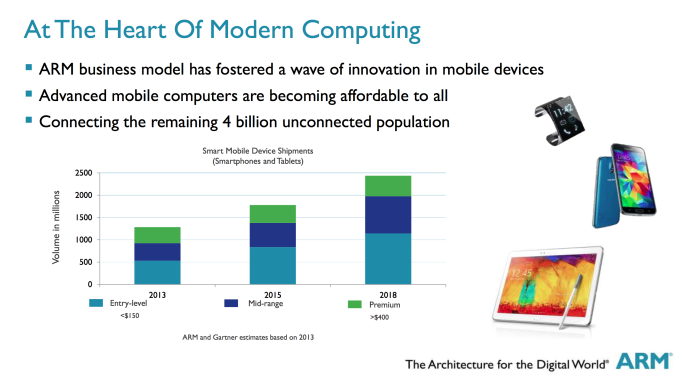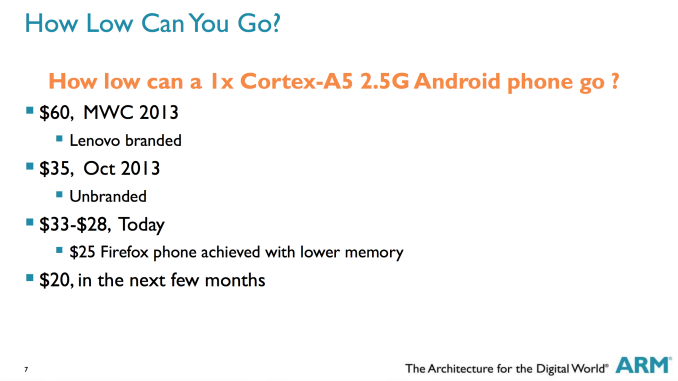ARM Expects ~1B Entry Level Smartphones in 2018, $20 Smartphones Coming This Year
by Anand Lal Shimpi on May 6, 2014 8:00 AM EST- Posted in
- Smartphones
- Arm
- Mobile
- SoCs

When we first started covering mobile, nearly every silicon vendor I spoke with issued the same statement: eventually, all phones are smartphones. Continued scaling on process technology, combined continued development of small/power efficient CPU cores, will ensure that even the lowest cost mobile devices will be smartphones.
At its second ever Tech Day, ARM shared some data about how the smartphone market is evolving. We often mention that the growth in the smartphone industry will shift from high-end devices to mid-range and entry level devices. The graph above shows just that. By 2018 ARM expects over a billion entry level (< $150) smartphone shipments per year, around 2x what it is today.
Two factors will drive entry level shipments: the performance of entry-level devices, and their overall cost. ARM believes the floor for an entry level smartphone running Android (today with a single-core Cortex A5 based SoC) is $20, and that we'll see the first devices on sale at that price point in the next few months. Manufacturing limits will likely prevent cost scaling below $20. Keep in mind that a single Cortex A5 is faster than the ARM11 in the original iPhone, which retailed for $599 in 2007.











31 Comments
View All Comments
StevoLincolnite - Tuesday, May 13, 2014 - link
I'm on prepaid and got a Lumia 920 a couple years ago (I think!)Paid about $500 AUD outright for it, the prepaid rates are actually cheaper, so I actually save money over the long term. :)
DanNeely - Tuesday, May 6, 2014 - link
At the same time, $55/mo is less than 2/3rds of the $90 (40 voice + 20 messaging + 30 data) VZW wanted as the smart phone entry price 7 or 8 years ago; it's slowly but steadily tricking downward, as VZW tries to convince more holdout's to upgrade. During the same time the price for a minimum voice plan only dropped $5. I expect the gap to keep getting narrower; and when they finally shutdown their 2g (and 3g) network - currently planned for 2021 - I suspect this sort of bottom end smartphone will be what they hand out to refuseniks for free without increasing their billing rate (the FCC requires them to do so when retiring a voice network), if only because by then I doubt there will be any non-smart phones available to offer instead.c933103 - Wednesday, May 7, 2014 - link
I think there are some nokia asha that support wcdma nowaday and will probably continue to be offered by the end of the decade..And for phone price plan, comparatively, here is a link to price plan in China, with ~6.2RMB=1USD: http://www.3gsolutions.com.cn/page/mthplan and note that there are also numerous traffic package available, which mean user would not needed to jump to a higher traffic plan for more data, (which according to http://s.taobao.com/search?q=%C1%F7%C1%BF%B0%FC&am... the price seem to be around 0.5USD per every 300MB per month)
Murloc - Wednesday, May 7, 2014 - link
you don't have to get any plan with a smartphone.People who have cheap traditional phones don't have a plan, why would they have to get it when they change to a smartphone?
There's wifi available in many places anyway so they're still more connected than before.
mkozakewich - Saturday, May 24, 2014 - link
The plan has nothing to do with the phone. Yes, you need a more expensive plan to get a $500 rebate if you're doing the two- or three-year thing and getting an expensive flagship device; but if your new phone is only $30, there's no need to even be on a plan. Just get a pay-as-you-go SIM, and make sure your new phone takes a SIM card.Sushisamurai - Tuesday, May 6, 2014 - link
so as this may be great news for our consumer habits, i personally do not think this is "great" news. With lower costs means lower margins; if the cost isn't coming from the materials, it's coming from other sources - perhaps even the workers that slave over the increased in demand for "cheap" phones/tech products.Not to mention the new added waste of tech that will be obsolete artificially sooner and the added cost for "flagship devices" (raw material supply cost will be buoyed as supply will be split between creating cheap phones to flagship)
usama_ah - Tuesday, May 6, 2014 - link
Everything you said in terms of analysis I think you're spot on. Except the part about worker/slaves I think this is in the end good, I'm hopeful this tech will cont to make lives easier (in many ways) for those in poverty. If the high end pays more for phones then so be it, though as mentioned before some of that segment will buy 'good enough' phones. And maybe the increase demand for material will push companies to push recycling harder.Hrel - Tuesday, May 6, 2014 - link
I would expect the high end phones to shrink, not grown in market share. I would also expect the mid range phones to grow more than shown, and the low end less than shown.Ideally we want a massive mid-range, and tiny high end and low end range.
$200 should get me a 4.4" 720p+ phone with the newest Android and 4G LTE on any Network. Which I still cannot find.
The larger problem is, of course, carriers are still charging for data, as if there's a direct cost association between 2GB of data and 20GB. That's the primary problem we need fixed.
It doesn't matter if you're phone is $20 if your monthly bill is $60, Verizon.
grant3 - Tuesday, May 6, 2014 - link
"... as if there's a direct cost association between 2GB of data and 20GB."Of course there's an association between being able to support 2x, 5x, or 10x as much data transfer. More towers, newer technology, more equipment, more power, more backbone, more technicians to manage... that stuff doesn't magically appear when millions of customers start filling up all the available bandwidth.
Is the price *increase* between tiers justified? Well that's a matter of consumer choice. Verizon will no doubt continue tweaking their pricing to extra the maximum profit possible from their entire customer base.
mkozakewich - Saturday, May 24, 2014 - link
Still, though, that's bandwidth. It would make a great deal of sense to charge for bandwidth rather than raw data.Dial-up can be a solid 2 KB/s when things are working nicely, which is 5 GB/month. So, if I wanted to use data constantly, you can pretend I'm paying $40/month for dial-up.
The main problem is that smartphones need a lot of data instantly, but don't generally use more than 1 GB every month (for their own tasks; I'm not counting YouTube and such). I'd like at least some basic tiering, though, so I could choose a 10Mbps line of the same amount of data for cheaper. It would help with congestion, too, unlike charging more for more GB/month would.